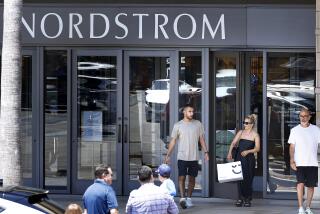Shearson’s Losses to Total $900 Million in First Quarter
- Share via
NEW YORK — Shearson Lehman Hutton Inc. said Monday that it will post a massive loss of $900 million in the first quarter, due to losses from operations and a restructuring charge believed to be the largest ever by a Wall Street firm.
The charge was widely expected after American Express Co., Shearson’s majority shareholder, said last month that it would buy the remainder of Shearson and launch a crash program to turn the troubled brokerage around.
Shearson said it expects that the restructuring charges will be $630 million and operating losses will be from $110 million to $130 million for the quarter. It also said it will have a one-time, $157-million charge related to the cumulative effect of accounting changes.
Shearson has been struggling to show a profit in the aftermath of the October, 1987, crash and its costly acquisition of E. F. Hutton & Co.
It launched a major restructuring that it said would cut its costs for the long term but lead to big losses in the short run.
Shearson said the restructuring charge reflects costs from an expense reduction program announced in February and plans to withdraw from or end certain business activities. The firm wants to focus its resources in areas that can grow profitably in the 1990s.
As a result of the charges and the capital enhancement program, Shearson said it expects to realize annualized improvements in profitability in excess of $400 million.
American Express agreed to pay shareholders about $310 million in stock for Shearson in a deal estimated at about $12.50 a share.
Analysts believe that American Express may seek to shift more of Shearson’s 37,000 employees to other areas and lay off some.
In addition to 2,000 previously announced staff cuts, they expect Shearson to pare another 2,000 to 3,000 employees over the next 12 months, unless market conditions improve.
Analysts said they also expect American Express to curtail some riskier merchant banking functions and refocus on retail operations, despite a downturn in the U.S. retail brokerage business.
Shearson said its operating results will also be hurt by special charges, including about $60 million from the closing of certain offices overseas, a charge of approximately $115 million from the planned sale of $480 million worth of high-yield securities and severance expenses of $45 million.
The industry’s largest brokerage firm, Merrill Lynch & Co., reported a $470-million charge in the fourth quarter of 1989 that was the securities industry’s largest charge to date.
The struggling securities industry has been grappling with a major downturn, marked by the collapse of the junk bond market and the 1987 stock market crash, which sidelined many investors. Last October’s plunge again hurt market confidence.
Wall Street firms have laid off thousands of employees and many have sold poorly performing businesses.
More to Read
Inside the business of entertainment
The Wide Shot brings you news, analysis and insights on everything from streaming wars to production — and what it all means for the future.
You may occasionally receive promotional content from the Los Angeles Times.










